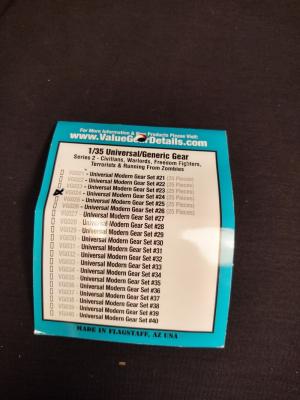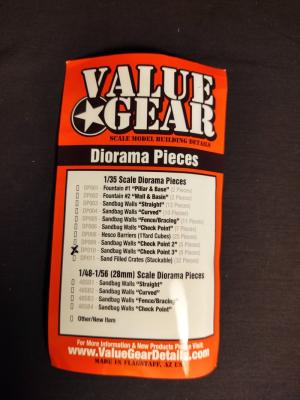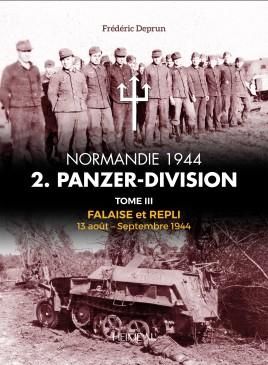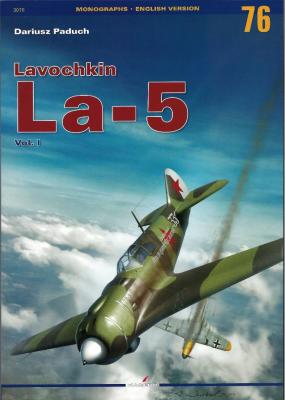Value Gear resin stowage products have long been among the best resin additions for modelers looking to detail their builds in nearly any scale. Spanning stowage from WWII through more modern and even sci-fi settings, these pieces really pop with detail and add immensely to the scenes they’re placed in. In this case, we are looking at set #11-- another stowage set for your StuG in 1/35 scale. While many of the sets are geared towards certain manufacturers’ kits, there is absolutely no reason why you can’t place them nearly anywhere, as you’ll see below.
Welcome to the IPMS/USA Reviews site!
Introduction: The primary organization of the IPMS/USA Review website is by IPMS/USA National Contest Class. Within each Class there are sub-menus by kits, decals, books, etc. The Miscellaneous Class is for items that are not class specific or that cross two or more classes.
IPMS/USA Members: We encourage you to submit reviews, both here and to the Journal. To volunteer for membership in the IPMS/USA "Reviewers Corps" and submit your own reviews, please read the Guidelines For Submitting Product Reviews.
Manufacturers, publishers, and other industry members: IPMS/USA is pleased to offer your company the opportunity for product reviews. All product reviews are performed by IPMS/USA members, and are posted in the publicly-accessible section of our website. With very few exceptions, we perform full build reviews of new kit releases, aftermarket products, and supplies. If you would care to provide product samples for review, please contact John Noack, IPMS/USA 1st VP.
To learn more about IPMS/USA, please see our About Us page.
Value Gear resin stowage products have long been among the best resin additions for modelers looking to detail their builds in nearly any scale. Spanning stowage from WWII through more modern and even sci-fi settings, these pieces really pop with detail and add immensely to the scenes they’re placed in. In this case, we are looking at set #11-- another stowage set for your StuG in 1/35 scale. While many of the sets are geared towards certain manufacturers’ kits, there is absolutely no reason why you can’t place them nearly anywhere, as you’ll see below.
This set contains 8 pieces and represents varying arrangements of sandbag emplacements that can be used in gun pits, checkpoints, roadblocks, bunkers, or really anywhere you might want some protection. There are a couple corner pieces, short and long straight pieces, and one large curved piece. Details are quite nice and involve crates and sandbags for the most part in various configurations.
C'est une magnifique publication, riche en prose et en photographie. Présentée en français, mon manque de maîtrise du français me fait passer à côté de la qualité de la prose, mais la photographie ne nécessite pas de traduction précise.
In English - This is a magnificent publication, rich in prose and photography. Presented in the French language, my lack of command of French means that I am missing out on the quality of the prose, but the photography and the captions for the images does not require precise translation.
This Is the third volume with the previous two volumes having been reviewed by IPMS in the past year. A message on the final page of Volume 3 states that a fourth and final volume will see the light of day, covering the period from Oct 1944 to May 1945 for the 2nd Panzer Division.
Based in Central Europe Kagero Publishing House is the biggest publisher and exporter of English-written publications about military history, release nearly 60 titles every year. Kagero was founded in 1995, and began by delivering military titles in Polish. Their success led Kagero to start releasing books in English in 1998. Authors from Poland, Canada, USA, Australia and Great Britain, who were invited to cooperation, gave a beginning to a new range of products, which have put them on a position of one of the most recognized publishers on the market. Kagero has released more than 550 publications. Kagero is managed by Damian Majsak and his wife Joanna.
Like many avid modelers of WW2 armor, I have to admit that until recently I had a major blind spot regarding Hungary’s contribution to the Axis cause. Amazingly for such a relatively small economy, Hungary possessed even then a robust arms industry. They did purchase armor from other sources, the most notable being Germany and Italy, but even so their home-grown products were comparable to some of the best equipment in the world at the time. I really have no idea how they’ve slipped under the modeling radar until recently.
Mr. Martinez’s book is absolutely stuffed with never-before-seen pictures of Hungarian armor, both indigenous and otherwise, and although printed completely in French, it still provides an excellent overview of this poorly documented subject. I spent some time translating the chapter and subchapter headings, which gives you some idea of the contents:















